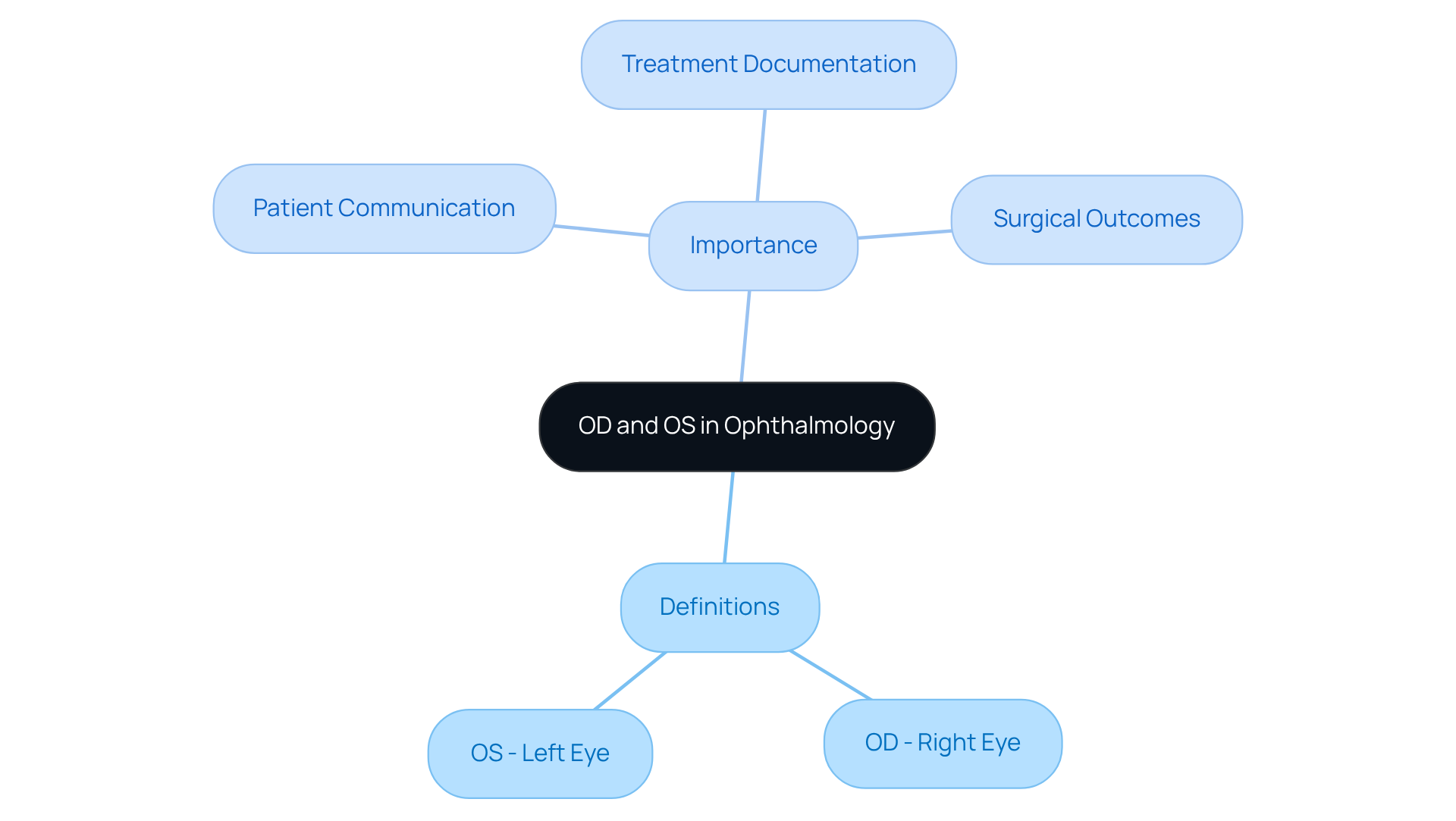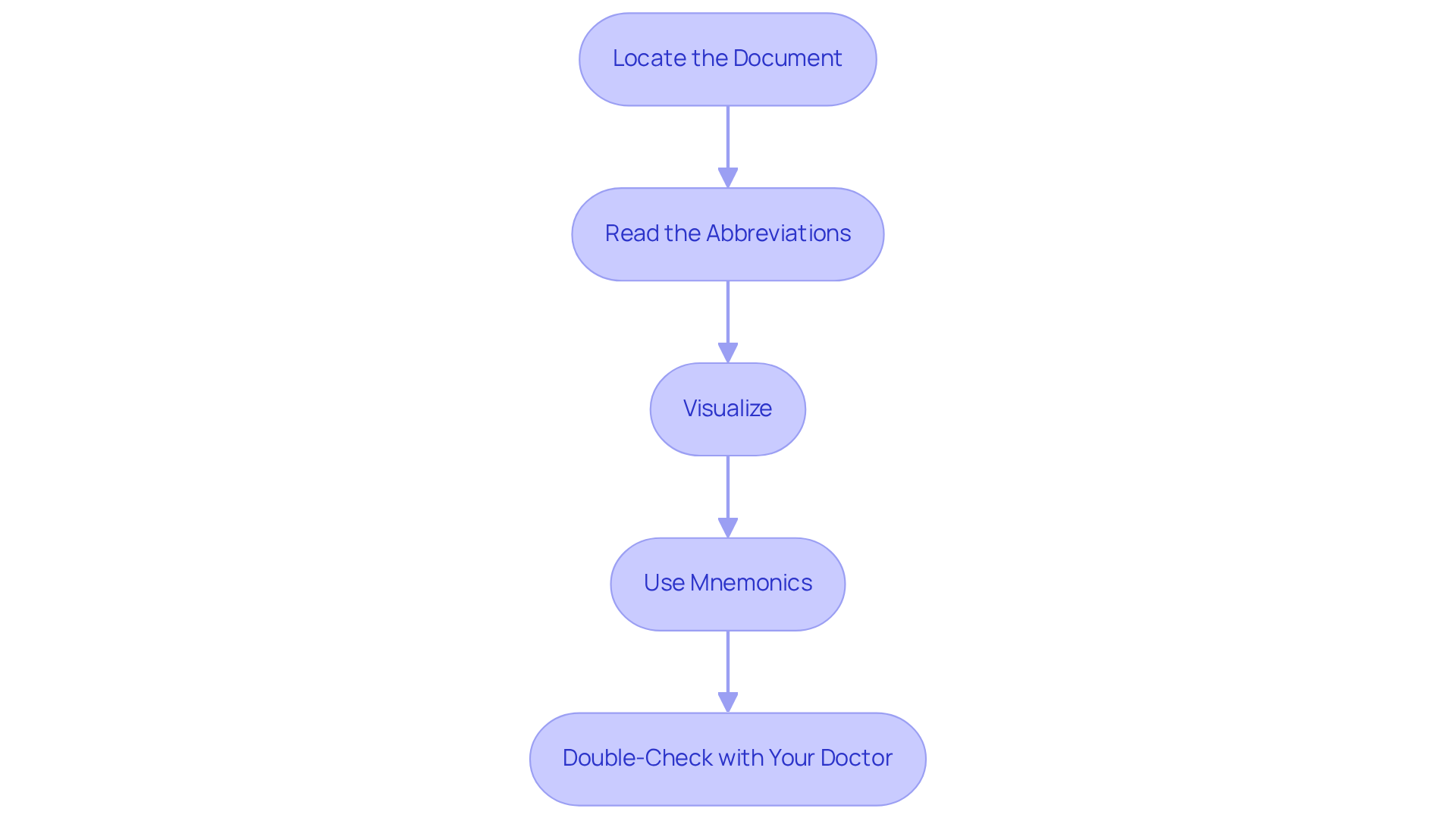Posted by: Northwest Eye in Cataract Surgery, Cataracts, Vision Correction on October 10, 2025
Overview
We understand that navigating eye care can be overwhelming. The article clarifies that OD stands for the right eye (Oculus Dexter), while OS refers to the left eye (Oculus Sinister). This distinction is essential for cataract patients, as it helps them accurately understand their prescriptions. When patients know that OD specifically designates the right eye, they can effectively communicate with their healthcare providers. This understanding not only enhances their engagement in treatment but also supports their involvement in surgical processes.
Remember, we are here to help you through this journey.
Introduction
Navigating the world of eye health can often feel daunting, especially for those facing cataract surgery. We understand that this journey may raise many questions and concerns.
Understanding the distinction between OD (Oculus Dexter) and OS (Oculus Sinister) is essential, as these terms denote the right and left eyes respectively. This knowledge not only facilitates clearer communication with healthcare providers but also empowers you to engage more effectively in your treatment plan.
However, it’s common to feel uncertain about which eye corresponds to which abbreviation. So, how can you confidently identify your left and right eyes on prescriptions to ensure optimal care and outcomes? We are here to help you through this process.
Understand OD and OS: Definitions and Importance
In the field of ophthalmology, we understand that navigating eye health can be challenging. When we refer to OD, we mean the right eye (Oculus Dexter), while the term is od left or right eye, with OS denoting the left eye (Oculus Sinister). These Latin terms are commonly found in orders, medical records, and conversations about your eye health. For those experiencing eye conditions, grasping the significance of these abbreviations is crucial, as they frequently appear in treatment documentation. Knowing which eye is od left or right eye can assist you in following your treatment plans more effectively and communicating clearly with your healthcare providers.
For example, a prescription stating ‘OD -2.00’ indicates that the right eye has a refractive error of -2.00 diopters, an important detail for planning lens surgery. It’s common to feel uncertain about these terms, as recent studies show that many patients lack clarity, which can affect their understanding of treatment options and outcomes. Ophthalmologists emphasize that having a solid grasp of OD and OS can greatly enhance your engagement and satisfaction during the surgical process.
Statistics reveal that lens opacities affect approximately 24.4 million Americans aged 40 and above, with the occurrence increasing significantly with age. By the time you reach age 80, more than half of individuals in the United States will have developed cataracts. This highlights the importance of clear communication regarding eye health. By effectively understanding OD and OS, you can work towards better surgical outcomes and overall safety.
We are here to help you through this process, ensuring you feel informed and supported every step of the way.

Identify Left and Right Eye: Step-by-Step Instructions
To help you identify which eye is which on your prescription, we’re here to guide you through these simple steps:
- Locate the Document: Begin by finding your most recent eye examination or medical record. This document will typically list your OD and OS values, which help determine if it is od left or right eye, and are essential for understanding your vision needs.
- Read the Abbreviations: Look for the abbreviations OD and OS. Remember, OD is od left or right eye, while OS is for your left eye. It’s important to recognize that these values can differ significantly, highlighting the uniqueness of your vision.
- Visualize: If you find it challenging to remember, visualize your face. The designation for the right eye is OD, while the left eye is referred to as OS, so is OD left or right eye?. This mental image can make it easier to recall.
- Use Mnemonics: A helpful mnemonic to remember is that ‘O’ in OD stands for ‘Oculus’ and ‘D’ for ‘Dexter’ (right), while ‘O’ in OS stands for ‘Oculus’ and ‘S’ for ‘Sinister’ (left). These associations can provide clarity.
- Double-Check with Your Doctor: If you’re ever unsure, don’t hesitate to ask your ophthalmologist or optometrist for clarification. They are here to support you and can offer further context to ensure you fully understand your prescription. Regular eye exams are also advised to maintain your eyewear specifications, which is essential for effectively managing your cataract treatment.
By following these steps, you can confidently identify which eye is od left or right eye, which will facilitate better communication with your healthcare providers. We understand that comprehending your eye requirements is vital, and we encourage you to engage in conversations about your visual health. Remember, you’re not alone in this journey; we are here to help you through the process.

Interpret Additional Prescription Details: Common Questions
When examining your eye assessment, you may encounter various details beyond what is OD left or right eye. We understand that this can feel overwhelming, so here are some common questions and their answers:
-
What do the numbers mean? The numbers next to OD (Oculus Dexter) and OS (Oculus Sinister) indicate which eye has the refractive error, specifically if it is OD left or right eye in diopters. A negative number signifies nearsightedness (myopia), while a positive number indicates farsightedness (hyperopia).
-
What is the significance of the cylinder (CYL) and axis? If your order includes CYL and axis values, these refer to astigmatism. The cylinder value indicates the degree of astigmatism, while the axis specifies the orientation of the astigmatism, which is crucial for accurate vision correction.
-
What is the importance of the pupillary distance (PD)? PD is the distance between your pupils and is essential for fitting glasses correctly. Ensure this measurement is included in your prescription to achieve optimal vision correction and comfort.
-
How often should I get my eyes checked? Routine eye examinations are essential, particularly for individuals with lens opacities. It is typically suggested to undergo an eye examination every one to two years, or more often if recommended by your eye care specialist. This helps track cataract development and overall visual wellbeing. As noted by eye care specialists, “Your eye doctor will want to see you at least once every year for an annual eye exam.”
-
What should I do if I have questions? Always feel free to contact your ophthalmologist or optometrist with any questions regarding your eyewear. They are here to assist you in understanding your eye condition and treatment alternatives, ensuring you feel assured in overseeing your vision.
By addressing these common questions, you can better interpret your prescription and feel more empowered in your eye care journey. Remember, cataracts are the leading cause of blindness in the United States, making it crucial to stay informed and proactive about your eye health.
![]()
Conclusion
Understanding the distinctions between OD and OS is essential for cataract patients navigating their eye health journey. We understand that recognizing that OD refers to the right eye and OS to the left eye can empower you to engage more effectively with your treatment plans. This knowledge not only aids in clear communication with healthcare providers but also enhances overall satisfaction during the surgical process.
Throughout this article, we provided key insights on how to identify which eye is which, interpret prescription details, and address common questions related to eye health. By following simple steps to locate and understand OD and OS values, you can ensure you are well-informed about your vision needs. Additionally, it’s common to feel overwhelmed, but the importance of regular eye examinations and proactive communication with eye care specialists cannot be overstated. These practices are vital for managing cataracts effectively.
Ultimately, being proactive in understanding eye prescriptions and the significance of OD and OS can lead to better outcomes in cataract treatment. We encourage you to take charge of your eye health by asking questions, seeking clarification, and staying informed. This commitment not only fosters a sense of empowerment but also contributes to achieving optimal vision and quality of life.
Frequently Asked Questions
What do the terms OD and OS mean in ophthalmology?
In ophthalmology, OD refers to the right eye (Oculus Dexter), while OS denotes the left eye (Oculus Sinister).
Why is it important to understand the terms OD and OS?
Understanding OD and OS is crucial for patients experiencing eye conditions, as these terms frequently appear in treatment documentation, helping patients follow their treatment plans effectively and communicate clearly with healthcare providers.
How does knowing OD and OS impact treatment plans?
Knowing which eye is referred to as OD or OS can assist patients in understanding their prescriptions and treatment options, ultimately enhancing their engagement and satisfaction during the surgical process.
What does a prescription like ‘OD -2.00’ indicate?
A prescription stating ‘OD -2.00’ indicates that the right eye has a refractive error of -2.00 diopters, which is important for planning lens surgery.
What is the significance of lens opacities in relation to eye health?
Lens opacities affect approximately 24.4 million Americans aged 40 and above, with the occurrence increasing significantly with age. By age 80, more than half of individuals in the United States will have developed cataracts, highlighting the need for clear communication about eye health.
How can understanding OD and OS improve surgical outcomes?
By effectively understanding OD and OS, patients can work towards better surgical outcomes and overall safety, as it facilitates clearer communication with their healthcare providers.






